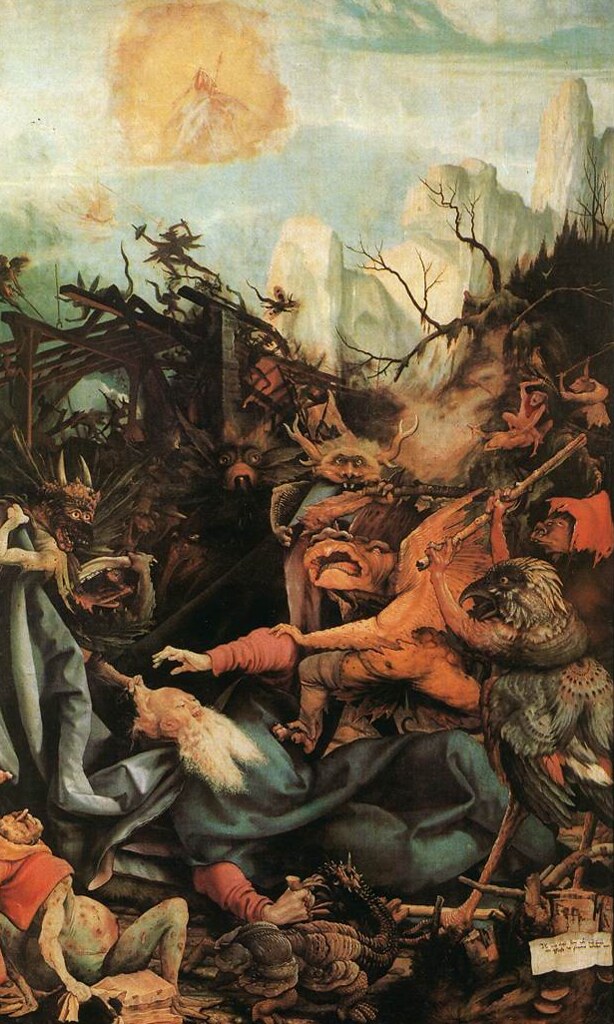 The Gods Themselves is a novel by Asimov. One of the few - perhaps the only one of his - to feature aliens; and quite decent aliens too. Whereas the picture, as you'll instantly recognise, is one of the Temptation of St Antony, a theme that appealed to the more psychedelic (psychotic?) painters. Temptation is rather an odd word, because although he is tempted by Lust and all the usual, rather more of the story seems to involve him being beaten, perhaps to death, by demons.
The Gods Themselves is a novel by Asimov. One of the few - perhaps the only one of his - to feature aliens; and quite decent aliens too. Whereas the picture, as you'll instantly recognise, is one of the Temptation of St Antony, a theme that appealed to the more psychedelic (psychotic?) painters. Temptation is rather an odd word, because although he is tempted by Lust and all the usual, rather more of the story seems to involve him being beaten, perhaps to death, by demons.But its also totally irrelevant, because I wanted to talk about the lesson from TGT. I've just re-read it for the first time in many years. I remembered the outline of the story, but not the details. Let me tell you the outline.
Aliens (it later emerges) are sending (from their universe, in which the strong nuclear force is stronger than ours) blobs of Pu-186 into ours, in exchange for W-186. As the laws of physics leak into the new material it becomes radioactive; a source (when developed) of limitless free unpolluting energy for both sides. Alas, there is a catch: as the alien law of stronger nuclear force leaks in, our sun risks exploding; but scientists disagree whether the laws dissipate at the speed of light, or more slowly (and hence more dangerously). Eventually, rebel (so to speak) scientists on the moon find a way to pull mass from an even-weaker-nuclear-force universe, and we end up happily in the middle, law balanced.
Naturally, to make a decent story the tension must be maintained, so there is a fair bit of academic rivalry, but also the book does a decent job of making it entirely plausible that people will risk destroying the world in exchange for free energy, and will overlook evidence to the contrary if it is at all marginal; and that to convince them, you must offer a solution. Hmmm, make you think of anything? It also features - well, the title comes from - the famous Against stupidity the gods themselves contend in vain, which I'm sure we've all used uselessly in our time. The book is 1972, so it is a bit early for the moral I've drawn to be intended to be present. I haven't found any reviews that say it is.
[Update: don't you hate it when you forget to give a post a title and then see what Feedly makes of it?]
> 1972 ... a bit early
ReplyDeleteOh, not hardly: https://www.google.com/search?q=%22Isaac+asimov%22+%22climate+change%22
Isaac Asimov global warming 1989.wmv - YouTube
Video for "Isaac asimov" "climate change"
▶ 5:05
https://www.youtube.com/watch?v=sSqdklAux-c
Sep 29, 2012 - Uploaded by Peter Carter
Peter Carter. ... Part of a lecture by Isaac Asimov warning of global warming in New York 1989....
Climate Change and Humanity (1989) - YouTube
Video for "Isaac asimov" "climate change"
▶ 9:59
https://www.youtube.com/watch?v=QfB7Hzb7G2Q
May 7, 2017 - Uploaded by Mathew Gauvin
In 1989, Isaac Asimov (my hero), warned that Climate Change was the most important scientific event for ...
PS, don't forget _Waldo_ (1942)
ReplyDeletehttps://en.wikipedia.org/wiki/Waldo_(short_story)
"... Waldo must figure out what effect broadcast power has on humans. Grimes is seeing a slow weakening of the human physique, and he blames the radiant power industry .... Radiant power is affecting the human nervous system. People feel weak, rundown, fretful ....
....
... he unveils the "Jones-Schneider deKalb", a Rube Goldberg contraption which appears to draw power from nowhere. ...."
I have my suspicions about ubiquitous wi-fi ...
https://www.technologyreview.com/s/600773/10-breakthrough-technologies-2016-power-from-the-air/